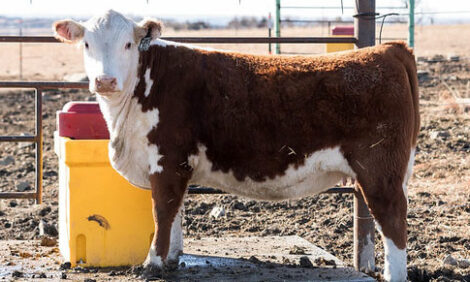



Bovine Trichomoniasis In The US
Trichomoniasis is a venereal disease of cattle, characterised primarily by early pregnancy loss and, occasionally, by abortion and pyometra. Charlotte Johnston, TheCattleSite editor speaks with Dr Keith Roehr, Colorado State Vet, about the disease.In Colorado, bovine trichomoniasis (trich) is a reportable disease. A control programme has been in place for over eight years, and to date less than one per cent of herds in the state are infected.
However this hasn't always been the case, in fact it has only been in the last year, that significant progress in controlling the disease has been made.
In 2007, there were 32 infected herds in the state, the following this year increase to 48 and in 2009, there were a total of 60 infected herds.
In 2010, only nine herds were infected - a significant improvement.
Trich isn't just a problem in Colorado. Dr Roehr says that all states West of the Mississippi have problems with trich.
"It is not possible to permanently eradicate the disease from cattle," said Dr Roehr.
However thanks to increased awareness, the number of cases has fallen significantly.
Dr Roehr said that states with high incidences included Texas, Oklahoma, Louisiana and Arkansas. He said that these states had less experience and time spent on implementing control programmes.
Symptoms
There is no outward evidence of the disease that makes it recognisable to producers, said Dr Roehr. It can only be confirmed by tests. Trich, does however, significantly reduce fertility, which can have a devastating economic impact for producers.
The disease is spread between cows, by bulls. Any bull found with the disease must be culled. Dr Roehr says that the majority of cows (97-99 per cent) will self clear of the disease within 120 days.
Whilst it is beneficial that cows can clear themselves of the disease, during this time period they will have missed a valuable time frame for coming into calf.
There are no accepted treatments out there for trich, said Dr Roehr, and there is a possibility that the disease may re-occur within cows.
With this in mind he advices producers to sell non-pregnant cows.
Prevention
Bulls should be tested annually for trich. This, Dr Roehr said, is an excellent strategy to ensure that trich is not present in herds.
He also advised producers against buying non-pregnant cows, as they may be a source of the infection.
It is hard to put a dollar figure on trich, said Dr Roehr. However, if a producer only has a 50 per cent pregnancy rate for one season, that could put him out of business.
There is mandatory testing of all bulls when they are imported or change ownership. However frequent bull testing will control the disease, within the state, he said.
Concluding, Dr Roehr advised producers to work with their local veterinarians to subscribe a plan that works with each individual herd. It is also advisable to test bulls before breeding.


